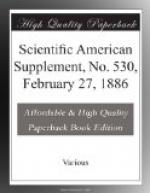In the second particular he maintained that owing to the characteristics of the Panama Canal and the practical impossibility of enlarging it hereafter, excepting at stupendous cost, it could not serve the purposes of the future, although it might, if completed, supply present need. He praised the ingenuity of the plans for the Ship Railway, but emphasized the fact that it will be the movement of the traffic, not merely the lifting and supporting of ships in transit, that will test the system, and suggested that even the beautiful application of mechanical force which had been contrived might be powerless to insure the high grade of service which is an absolute necessity. In this connection the general features of the Nicaragua Canal, in its latest form, were referred to, and the opinion expressed that even were all difficulties in the way of the Ship Railway eliminated, it could not be superior to the canal in respect of adaptiveness.
In point of political security he claimed that both Tehuantepec and Nicaragua were reasonably free from doubts, with the advantage in favor of the latter, while at Panama no security, for United States interests at least, could be counted on, without the liability of a military expenditure far exceeding the cost of the canal itself.
The matter of comparative cost of construction and operation was discussed generally, and in conclusion the author stated that “this all-important question is still an open one, of which the future needs of our country justify and demand at this time a most searching scrutiny, and moreover our interest and the interest of mankind require that before this century closes, the best possible pathway between the Atlantic and the Pacific shall be open to the navies of the world.”
The paper was illustrated with maps and diagrams.
* * * * *
THE MERSEY TUNNEL.
The Mersey Tunnel was lately opened by the Prince of Wales, and, as the London Standard says, after an infancy of troubles and failures, and a ten years’ middle age of inaction, the Mersey Tunnel emerges into notoriety under the hands of Mr. James Brunlees and Mr. C.D. Fox, and of Mr. Waddell, the contractor, as a triumph of engineering skill. The tunnel is 1,250 yards in length. It is driven through solid, but porous, red sandstone, through which the water has percolated in volumes during construction, at a level of about 30 feet below the bed of the river. It is lined throughout with blue bricks, the brickwork of the invert being 3 feet in thickness. Its transverse section is a depressed oval 26 feet in width and 21 feet in height, and it contains two lines of railway. At a depth of about 18 feet below the main tunnel there is a continuous drainage culvert 7 feet in diameter, entered at intervals by staple shafts. There are two capacious underground terminal stations 400 feet long, 50 feet broad, and 38 feet




